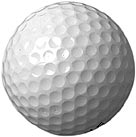Solar & Battery Fan DIY STEM Kit
$9.99$6.50
 No less than four principles are used to explain the movement of objects such as
golf balls as they travel through the air. Since air is considered a fluid, then
fluid dynamics, or the characteristics of moving fluids or objects moving through
them are described using a Reynold's number. This relationship is part of the
research done by British physicist Osborn Reynolds for which it is appropriately
named, and is a function of the viscosity of the air, the speed of the air and the
size and shape of the object moving through the air.
No less than four principles are used to explain the movement of objects such as
golf balls as they travel through the air. Since air is considered a fluid, then
fluid dynamics, or the characteristics of moving fluids or objects moving through
them are described using a Reynold's number. This relationship is part of the
research done by British physicist Osborn Reynolds for which it is appropriately
named, and is a function of the viscosity of the air, the speed of the air and the
size and shape of the object moving through the air.

 'After a certain high level of technical skill is achieved, science and art tend to coalesce in esthetics, plasticity, and form. The greatest scientists are always artists as well.'
'After a certain high level of technical skill is achieved, science and art tend to coalesce in esthetics, plasticity, and form. The greatest scientists are always artists as well.'